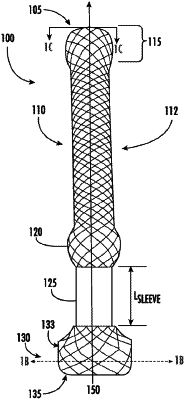| CPC A61F 2/848 (2013.01) [A61F 2/04 (2013.01); A61F 2/07 (2013.01); A61F 2/90 (2013.01); A61F 5/0079 (2013.01); A61F 2002/044 (2013.01); A61F 2220/0008 (2013.01)] | 20 Claims |

|
1. A device comprising an elongate tubular body configured for positioning across an anatomical constriction portion that regulates flow between a first anatomical flow path and a second anatomical flow path, the device comprising:
a proximal stent formed of a first material and having a tubular wall extending longitudinally between a proximal perimeter and a distal perimeter and defining an elongated exterior configured to anchor the proximal stent with respect to anatomical structure proximal to the anatomical constriction portion;
a distal stent having a tubular wall extending longitudinally between a proximal perimeter and a distal perimeter and defining an elongated exterior configured to anchor the distal stent with respect to anatomical structure distal to the anatomical constriction portion; and
a sleeve, formed of a second material different from and more flexible than the first material of the proximal stent, coupled around the distal perimeter of the proximal stent and the proximal perimeter of the distal stent;
wherein the sleeve is configured to extend through and to conform to the anatomical constriction portion, and to transition in coordination with the anatomical constriction portion between an expanded configuration enabling flow through the sleeve and a constricted configuration wherein flow through the sleeve is restricted while the proximal stent remains anchored to an anatomical structure proximal to the anatomical constriction portion and the distal stent remains anchored to an anatomical structure distal to the anatomical constriction portion; and
wherein the proximal stent, the distal stent, and the sleeve together define a central lumen providing a flow path through the elongate tubular body resistant to migration.
|